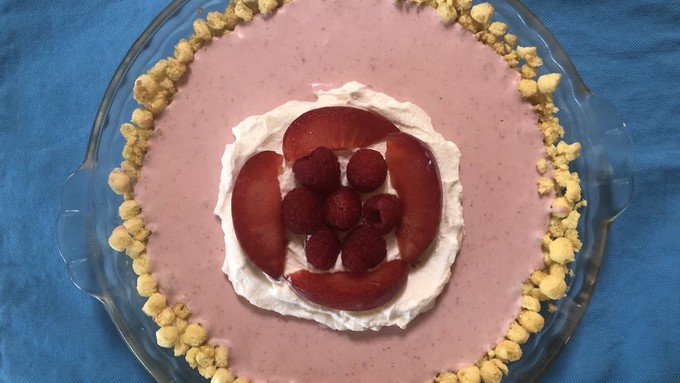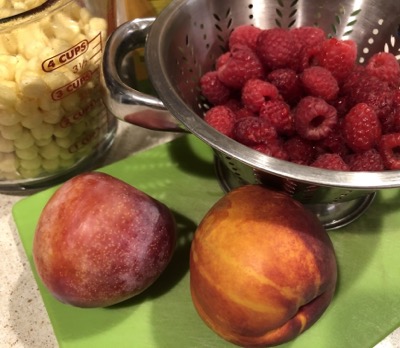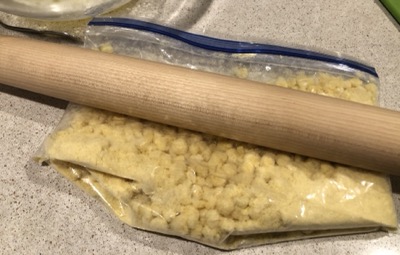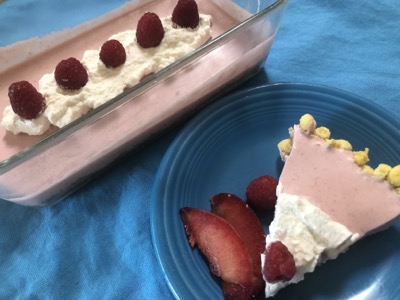
Recipe: Berries and stone fruit flavor a creamy treat

Raspberries and end-of-summer stone fruit make a creamy filling for a cereal crust. Kathy Morrison
Thinking of pie, and the end of the summer fruit season, but not wanting to turn on the oven – that was my dilemma. As much as I love them, regular fruit pies take forever to bake. And so much prep ahead of time! Too much for a heat wave, even with an excellent (thank goodness) A/C system.

So I went looking for no-bake pie inspiration online. Lots of graham cracker crusts, of course, filled with creamy concoctions. No calorie saving here! What caught my eye was a Taste of Home pie recipe that used cereal for the crust, making a very crunchy contrast to the cream cheese-based filling. This crust required 10 minutes in the oven to set, so not completely “no-bake.”
I belong to the “try anything once” school of cooking, so I decided to give this one a go. One big change: Instead of the original recipe’s Cap'n Crunch cereal, which is horribly sweet, I used Kix cereal, which has one-fourth the sugar of the Cap’n, yet is crunchy and corn-based.
This recipe turned out fussier than I’d originally hoped. I had raspberries I needed to use up, and some nectarines and pluots from the local farmstand, so I added those to fill out the amount of fruit and add some depth of flavor. The raspberries, once puréed, do need straining – lots of seeds!
An easier version would use strawberries instead of raspberries, or no berries at all but several ripe stone fruits. The nectarines weren’t labeled by variety, but when I cut into them, they were gorgeous purple-y red inside – which boosted the color of the filling. Plums would be good for this, too.
Tasting note: The cereal crust tasted fine, but after overnight time in the frig, it was more chewy than crunchy. If I were to make it again, I’d crush the cereal to fine crumbs, likely using the food processor to handle the job. So take that as your guide.
One more note: The filling recipe made way more than I needed for a 9-½-inch pie plate. So I made a half-recipe of graham cracker crust anyway, smashed it into a glass loaf pan and poured the excess filling over that. So: Make a graham cracker press-in crust (or buy two pre-made) if the cereal one strikes you as weird. (See above.) The full-pie recipe for the graham cracker crust is included below.
Cool and creamy end-of-summer fruit pie
8-12 servings
Ingredients:
Cereal crust:
2-3/4 to 3 cups crunchy cereal such as Kix, Cap’n Crunch original, or other favorite, finely crushed
½ cup butter

Filling:
2 cups washed berries and/or diced stone fruit
¾ cup granulated sugar, divided
Zest from 1 lemon
1 teaspoon fresh lemon juice
1 package unflavored gelatin
2 8-ounce packages cream cheese (look for organic), softened to room temperature
½ cup heavy whipping cream
Optional topping:
Sweetened whipped cream
Additional fruit
Instructions:
Preheat oven to 350 degrees F. If you haven’t already, finely crush the cereal in a zip-closed plastic bag or use a food processor. (I left some of the cereal mostly intact, which was a texture mistake, noted above.) Melt the butter in a large microwave-safe bowl, and stir in the crushed cereal.
Press the crust mixture onto the bottom and sides of a greased 9- to 10-inch deep-dish pie plate. The bottom of a glass works well for this. Bake the crust until set, 10 minutes. (Very sweet cereal might scorch, so watch it.) Allow to cool completely, or make room in the freezer for it to do a quick cooldown.

Make the filling: Combine the fruit, ½ cup of the sugar, and the lemon zest and juice. Allow to macerate for 10 minutes. Meanwhile, in a microwaveable dish or measuring cup, add the gelatin powder to ¼ cup cold water, and let stand 5 minutes.
Transfer the fruit mixture to a blender or food processor; pulse until the fruit is puréed and smooth. If needed, press the mixture through a wire mesh strainer to remove seeds. (Especially important if you use raspberries or blackberries.)
Microwave the gelatin mixture on high for about 10 seconds, to melt it. Stir it into the strained fruit mixture.
In a large bowl, beat the cream cheese and remaining ¼ cup sugar, by hand or using a mixer, until smooth. Gradually stir in the fruit mixture and the heavy cream (see photo). Transfer filling to crust – I used a large ladle to do so, rather than pour it, since it was obvious there was more than I needed to fill the crust.
Refrigerate the pie, covered, until set, at least 2 hours. To serve, top if desired with sweetened whipped cream and additional fruit.
Here’s the full graham cracker crust recipe; I halved it for the loaf pan.
1-½ cups finely crushed graham cracker crumbs (about 10 double crackers)
⅓ cup granulated sugar
6 tablespoons unsalted butter, melted
½ teaspoon ground cinnamon or other baking spice, optional
Combine all the ingredients and mix well. Press the mixture into a lightly greased pie plate using the bottom of a glass. Let it chill for an hour before filling. Alternatively, bake it for 7 minutes at 375 degrees, then cool before filling.
Comments
0 comments have been posted.Sacramento Digs Gardening to your inbox.
Sites We Like
Garden Checklist for week of July 21
Your garden needs you!
* Keep your vegetable garden watered, mulched and weeded. Water before 8 a.m. to reduce the chance of fungal infection and to conserve moisture.
* Feed vegetable plants bone meal, rock phosphate or other fertilizers high in phosphate to stimulate more blooms and fruiting. (But wait until daily high temperatures drop out of the 100s.)
* Don’t let tomatoes wilt or dry out completely. Give tomatoes a deep watering two to three times a week.
* Harvest vegetables promptly to encourage plants to produce more. Squash especially tends to grow rapidly in hot weather. Keep an eye on zucchini.
* Pinch back chrysanthemums for bushy plants and more flowers in September.
* Remove spent flowers from roses, daylilies and other bloomers as they finish flowering.
* Pinch off blooms from basil so the plant will grow more leaves.
* Cut back lavender after flowering to promote a second bloom.
* It's not too late to add a splash of color. Plant petunias, snapdragons, zinnias and marigolds.
* From seed, plant corn, pumpkins, radishes, winter squash and sunflowers.